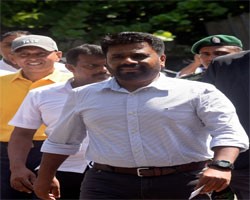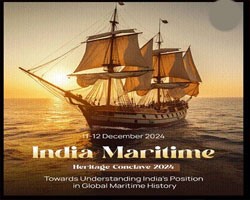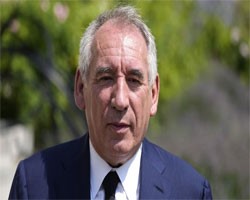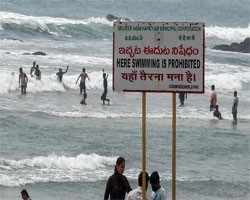SSC Current Affairs
TABLE OF CONTENTS |
| International Relations |
|---|
|
|
|
Why in the news?
Sri Lankan President Anura Kumara Dissanayake will visit India from December 15 to 17, the Foreign Ministries of the two countries said, announcing his first state visit abroad since he won the Presidency in September and his party swept the polls in the November general elections. Key Takeaways: 📍During his visit, President Disanayaka will meet Rashtrapati Ji and hold discussions with Prime Minister Shri Narendra Modi on bilateral issues of mutual interest. 📍President Disanayaka will also participate in a business event in Delhi to promote investment and commercial linkages between India and Sri Lanka. Further, he will visit Bodh Gaya as part of the visit. 📍Sri Lanka is India’s closest maritime neighbour in the Indian Ocean Region (IOR) and holds a central place in Prime Minister’s vision of ‘SAGAR’ (Security and Growth for All in the Region) and India’s ‘Neighbourhood First’ policy. 📍The visit of President Disanayaka to India is expected to further strengthen the multi-faceted and mutually beneficial cooperation between the two countries. About Mahabodhi Temple Complex: The Maha Bodhi Temple Complex is one of the four holy sites related to the life of the Lord Buddha, and particularly to the attainment of Enlightenment (Bodhi). It is located in Bodh Gaya, in central Bihar, on the banks of the Niranjana River. The other three are: Lumbini (Birth) in Nepal, Sarnath (Dharma-Chakra-Pravartana - 1st Sermon) and Kushinagar (Mahaparinirvana- death) in Uttar Pradesh. The first temple was built by Emperor Asoka in the 3rd century B.C., and the present temple dates from the 5th or 6th centuries. It is one of the earliest Buddhist temples built entirely in brick, still standing from the late Gupta period, and it is considered to have had a significant influence in the development of brick architecture over the centuries. The sculpted stone balustrades are an outstanding early example of sculptural reliefs in stone. It was recognized as a UNESCO World Heritage Site in 2002. Features: The present Temple Complex comprises the 50-meter-high grand Temple, six sacred places within an enclosed area, and a seventh one, the Lotus Pond, just outside the enclosure to the south. The most important of the sacred places is the giant Bodhi Tree. This tree is to the west of the main temple and is supposed to be a direct descendant of the original Bodhi Tree, under which the Buddha had his enlightenment. Ashoka’s stone slab purporting to mark the exact position where the Buddha sat is traditionally called the Buddha’s vajrasana (literally “diamond throne” or “thunder seat”). The grand temple’s pyramidal shikhara (tower) comprises several layers of niches, arch motifs, and fine engravings. Four towers, each identical to its central counterpart but smaller in size and topped with an umbrella-like dome, adorn the corners of the two-story structure. A shrine inside the temple holds a yellow sandstone statue of the Buddha encased in glass. The 4.8-hectare (11.9-acre) complex also includes ancient shrines and modern structures built by Buddhist devotees. SAGAR: Security and Growth for All in the Region (SAGAR) was launched in 2015. It is India’s strategic vision for the Indian Ocean Region (IOR). Through SAGAR, India seeks to deepen economic and security cooperation with its maritime neighbours and assist in building their maritime security capabilities. Further, India seeks to safeguard its national interests and ensure Indian Ocean region to become inclusive, collaborative and respect international law. The key relevance of SAGAR emerges when seen in conjunction with India’s other policies impacting the maritime domain like Act East Policy, Project Sagarmala, Project Mausam, India as ‘net security provider’, focus on Blue Economy etc. The SAGAR doctrine is defined as follows: Maritime Security Maritime Cooperation Economic Cooperation Capacity Building Sustainable Development Collective Action Neighbourhood First Policy: India’s ‘Neighbourhood First policy’ guides its approach towards the management of relations with countries in its immediate neighbourhood, that is, Afghanistan, Bangladesh, Bhutan, Maldives, Myanmar, Nepal, Pakistan and Sri Lanka. The policy officially came to being in 2008. Aim: The Neighbourhood First policy, inter alia, is aimed at enhancing physical, digital and people to people connectivity across the region, as well as augmenting trade and commerce. This policy has evolved into an institutional priority for all the relevant arms of the Government managing relations and policies with our neighbourhood. |
|
|
|
Useful information for all competitive exams:
Sri Lanka: Sri Lanka, historically known as Ceylon, and officially the Democratic Socialist Republic of Sri Lanka, is an island country in South Asia. Capital: Sri Jayawardenepura Kotte (legislative), Colombo (executive and judicial) Government: Unitary semi-presidential republic President: Anura Kumara Dissanayake Prime Minister: Harini Amarasuriya Currency: Sri Lankan rupee (Rs) (LKR) |
| National |
|
|
|
Why in the news?
The 1st India Maritime Heritage Conclave (IMHC 2024), a landmark event organized by the Ministry of Ports, Shipping and Waterways (MoPSW) was held on December 11-12, 2024. This prestigious gathering celebrated India’s illustrious maritime legacy and its profound contributions to global trade, culture, and innovation. Bringing together ministers, experts, and dignitaries from around the world, the conclave served as a vibrant platform for dialogue and collaboration, reaffirming India’s enduring maritime heritage and its pivotal role in shaping the global maritime narrative. History of India’s maritime heritage: India’s maritime heritage is deeply rooted in its ancient traditions and rich history, with references to maritime activities found as early as the Rig Veda. Indian mythology abounds with tales of the ocean, rivers, and the bounty they bestow upon humanity, symbolizing the profound connection between mankind and the seas. Evidence from Indian literature, art, sculpture, painting, and archaeology underscores the existence of a vibrant maritime tradition that shaped the nation's identity. Modern India's maritime prowess manifests across all domains with its impressive 7,500 km coastline, 13 major ports, and 200 non-major ports, establishing it as an undisputed maritime powerhouse. Indian port's remarkable annual handling capacity of 1,200 million tonnes of cargo underscores the maritime sector's pivotal role in our economic landscape. The maritime sector facilitates an extraordinary 95% of India's trade volume, and that accounts for 70% of its value, capitalising on our strategic Indian Ocean position. About India Maritime Heritage Conclave 2024: The 1st India Maritime Heritage Conclave (IMHC 2024) centered around the theme, "Towards Understanding India's Position in Global Maritime History." This landmark event convened key ministers, eminent speakers, maritime experts, and thought leaders from across the globe to illuminate India's illustrious seafaring legacy. The discussions underscored India’s pivotal role in fostering cultural and economic exchanges throughout history, while also exploring its forward-looking vision for sustainable maritime innovation. The conclave not only celebrated India’s historical maritime achievements but also highlighted its aspirations as an emerging maritime powerhouse on the global stage. The keynote sessions and panel discussions on India’s maritime legacy seamlessly interconnected, offering a comprehensive exploration of the nation’s historic contributions to global trade, culture, and innovation. Representatives from 11 countries joined the two-day conclave held in the capital, highlighting the event's international significance. 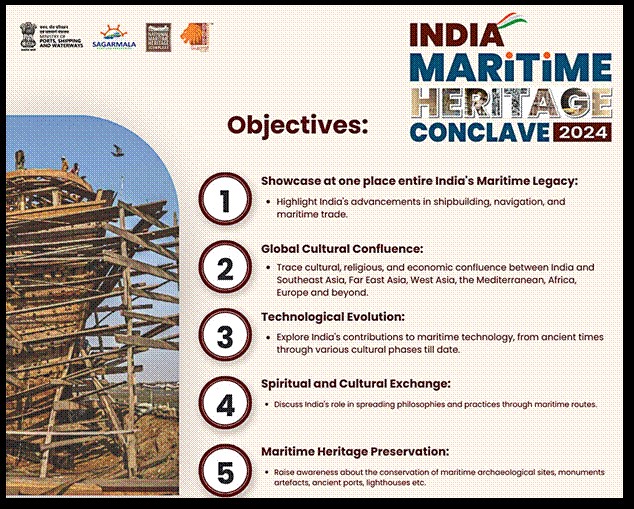 National Maritime Heritage Complex: National Maritime Heritage Complex:The Ministry of Ports, Shipping and Waterways is developing a National Maritime Heritage Complex (NMHC) at Lothal. It is one of the prominent cities of the ancient Harappan civilization dating to 2600 BCE. Here, archaeological excavations have discovered the oldest manmade dockyard, over 5000 years old. A Roadmap for the Future: The conclave not only celebrated India’s maritime achievements but also outlined a path for the future. With its robust coastline, advanced ports, and ambitious initiatives like the National Maritime Heritage Conclave, India is poised to become a maritime leader. The discussions on sustainable blue economy practices further reinforced the vision of a resilient maritime sector driving India’s economic and cultural resurgence. |
|
|
|
IN SHORT:
The 1st India Maritime Heritage Conclave (IMHC 2024), a landmark event organized by the Ministry of Ports, Shipping and Waterways (MoPSW) was held on December 11-12, 2024. The 1st India Maritime Heritage Conclave (IMHC 2024) centered around the theme, "Towards Understanding India's Position in Global Maritime History." The Ministry of Ports, Shipping and Waterways is developing a National Maritime Heritage Complex (NMHC) at Lothal. |
| Persons in News |
|
|
|
French President Emmanuel Macron named Francois Bayrou his third prime minister of 2024, tasking the veteran centrist with steering the country out of its second major political crisis in the last six months.
France's festering political malaise has raised doubts about whether Macron will complete his second presidential term, which ends in 2027. |
|
|
|
IN SHORT:
Francois Bayrou is expected to put forward his list of ministers in the coming days France's festering political malaise raises doubts about whether Macron will complete his second presidential term Bayrou has himself run for president three times |
|
|
|
Useful information for all competitive exams:
France: France, officially the French Republic, is a country located primarily in Western Europe. Capital: Paris Government: Unitary semi-presidential republic President: Emmanuel Macron Prime Minister: François Bayrou Currency: Euro (€) (EUR), CFP franc (XPF) |
| Reports And Indices |
|
|
|
Why in the news?
The World Health Organization (WHO) published its first-ever global status report on drowning prevention on December 13, 2024. The report, released at an event in Geneva, reveals that three lakh people died by drowning in 2021 around the world (an estimated 30 every hour). Key Takeaways: 📍The World Health Organization has called on countries in South-East Asia Region to strengthen measures to prevent drowning which disproportionately affects children and the vulnerable population. 📍As per WHO’s first Global status report on drowning prevention, the Region reported 83000 drowning fatalities in 2021, which accounts to 28% of the global drowning burden and contributing substantially to the nearly 30 lives lost to drowning every hour, globally. 📍Nearly 43% drowning fatalities in the Region involved children aged 14 years or younger. Drowning is the third leading cause of death for children aged 5–14 years and the fourth leading cause of death for children aged 1–4 years. 📍Compiled with the participation of 139 countries including India – the report found that while drowning deaths declined 38% since 2000, the progress had been uneven and the pace slow. The WHO’s European Region, for instance, saw a 68% drop, while the South East Asia Region saw a decline of 48%. Children at risk: Primarily at risk are children and young people. Children aged under five accounted for the single largest share of drowning deaths (24%), with a further 19% of deaths among children aged five to 14, and 14% among young people aged 15 to 29. The report notes that globally, drowning is the fourth leading cause of death for children in the age group of one-four and the third leading cause of death for children aged five to 14. Training crucial: The report also states that while encouragingly, the WHO’s evidence-based drowning prevention interventions are being implemented in many countries, the implementation is to varying degrees. For instance, only 33% of countries offer national programmes to train by standers in safe rescue and resuscitation, and just 22% integrate swimming and water safety training into their school curriculum. IN SHORT: Report name: Global status report on drowning prevention Who released: The World Health Organization (WHO) Edition: 1st Released at: Geneva |
|
|
|
Useful information for all competitive exams:
World Health Organization (WHO): The World Health Organization (WHO) is a specialized agency of the United Nations responsible for global public health. Formation: 7 April 1948 Type: United Nations specialized agency Headquarters: Geneva, Switzerland (Tedros was born in Asmara, Ethiopia (now in Eritrea) Director-General(8th): Tedros Adhanom Ghebreyesus Parent organization: United Nations Economic and Social Council |
|
<< 13-Dec-24
|
|
|
